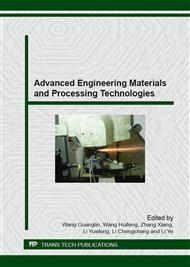[1]
N. T. Wang, Y. L. Qian, Y. Li, Q. Q. Zhuo, and T. P. Li, A Survey on Evolvable Hardware and Embryonic Hardware, in Proceedings of 2013 IEEE 11th International Conference on Electronic Measurement & Instrument, 2013, pp.1405-1450.
DOI: 10.1109/icemi.2013.6743207
Google Scholar
[2]
D. Mange, E. Sanchez, and A. Stauffer, Embryonics: A New Methodology for Designing Field-Programmable Gate Arrays with Self-Repair and Self-Replicating Properties, IEEE Transactions on Very Large Scale Integration (VLSI) Systems, vol. 6, pp.387-399, (1998).
DOI: 10.1109/92.711310
Google Scholar
[3]
D. Bradley, C. Ortega-Sanchez, and M. Andrew, Embryonics + Immunotronics: A Bio-Inspired Approach to Fault Tolerance, " in Proceedings of 2nd NASA/DoD Workshop on Evolvable Hardware(EH, 00), Palo Alto, California, USA, 2000, pp.215-224.
DOI: 10.1109/eh.2000.869359
Google Scholar
[4]
A. Stauffer, D. Mange, G. Tempesti, and E. Al, BioWatch: A Giant Electronic Bio-Inspired Watch, " in Proceedings of 3rd NASA/DoD Workshop on Evolvable Hardware(EH, 01), Long Beach, California, USA, 2001, pp.185-192.
DOI: 10.1109/eh.2001.937961
Google Scholar
[5]
M. Samie, G. Dragffy, and T. Pipe, UNITRONICS: A Novel Bio-Inspired Fault Tolerant Cellular System, in 2011 NASA/ESA Conference on Adaptive Hardware and Systems (AHS-2011), 2011, pp.58-65.
DOI: 10.1109/ahs.2011.5963967
Google Scholar
[6]
Z. Ji, T. Tian, and Z. X. Zhu, The survey on evolvable hardware research, JOURNAL OF SHENZHEN UNIVERSITY SCIENCE AND ENGINEERING, vol. 28, pp.255-263, (2011).
Google Scholar
[7]
Y. Li, N. T. Wang, and Y. L. Qian, Self-healing circuit design inspired by prokaryotic cell, JOURNAL OF NATIONAL UNIVERSITY OF DEFENSE TECHNOLOGY, vol. 34, pp.154-157, (2012).
Google Scholar
[8]
N. T. Wang, Y. L. Qian, Y. Li, Q. Q. Zhuo, and T. P. Li, Study of embryonic type on-line self-healing FIR filters, Chinese Journal of Scientific Instrument, vol. 33, pp.1385-1391, (2012).
Google Scholar
[9]
Q. Q. Zhuo, Y. L. Qian, Y. Li, N. T. Wang, and T. P. Li, Embryonic Electronics: State of the Art and Future Perspective, in Proceedings of 2013 IEEE 11th International Conference on Electronic Measurement & Instrument, 2013, pp.140-146.
Google Scholar
[10]
J. Manuel Moreno, Y. Thoma, E. Sanchez, O. Torres, and G. Tempesti, Hardware realization of a bio-inspired POEtic tissue, in Evolvable Hardware, 2004. Proceedings. 2004 NASA/DoD Conference on, 2004, pp.237-244.
DOI: 10.1109/eh.2004.1310836
Google Scholar
[11]
Y. Thoma, G. Tempesti, and E. Sanchez, POEtic: An Electronic Tissue for Bio-inspired Cellular Applications, Biosystem, vol. 76, pp.191-200, (2004).
DOI: 10.1016/j.biosystems.2004.05.023
Google Scholar
[12]
A. Upegui, Y. Thoma, H. E. F. Satiz´Abal, F. Mondada, P. R´Etornaz, Y. Graf, A. Perez-Uribe, and E. Sanchez, Ubichip, Ubidule, and MarXbot: A Hardware Platform for the Simulation of Complex Systems, in ICES2010, Berlin, 2010, pp.286-298.
DOI: 10.1007/978-3-642-15323-5_25
Google Scholar
[13]
A. Upegui, Y. Thoma, E. Sanchez, A. Perez-Uribe, J. M. Moreno, and J. Madrenas, The Perplexus bio-inspired reconfigurable circuit, in Adaptive Hardware and Systems, 2007. AHS 2007. Second NASA/ESA Conference on, 2007, pp.600-605.
DOI: 10.1109/ahs.2007.105
Google Scholar
[14]
M. Samie, G. Dragffy, A. Popescu, and C. Melhuish, Prokaryotic Bio-Inspired System, in 2009 NASA/ESA Conference on Adaptive Hardware and Systems, 2009, pp.171-178.
DOI: 10.1109/ahs.2009.45
Google Scholar
[15]
M. Samie, G. Dragffy, A. Popescu, T. Pipe, C. Melhuish, and I. E. C. Soc, Prokaryotic Bio-Inspired Model for Embryonics. Los Alamitos: IEEE Computer Soc, (2009).
DOI: 10.1109/ahs.2009.45
Google Scholar
[16]
N. T. Wang, Y. L. Qian, Y. Li, and Q. Q. Zhuo, A Self-healing PID Controller Based on Bio-inspired Multi-layer Structural Architecture, presented at the ICEEE2014, (2014).
Google Scholar
[17]
W. Wang, L. Qiao, and Z. Z. Tang, Survey on the Networks-on-Chip Interconnnection Topologies, Computer Science, vol. 38, pp.1-5, 12, (2011).
Google Scholar
[18]
S. Chai, Y. Li, J. Wang, and C. Wu, A Genetic Algorithm for Task Scheduling on NoC Using FDH Cross Efficiency, MATHEMATICAL PROBLEMS IN ENGINEERING, (2013).
DOI: 10.1155/2013/708495
Google Scholar
[19]
K. F. Xing, Single Event Effect Detection and Mitigation Techniques for Spaceborne Signal Processing Platform, National University of Defense Technology, Changsha, China, (2007).
Google Scholar
[20]
S. S. Yang, Research on the Circuit Design and Self-repairing Method of Embryonic Bio-inspired Hardware, Nanjing University of Aeronautics and Astronautics, Nanjing, (2007).
Google Scholar


